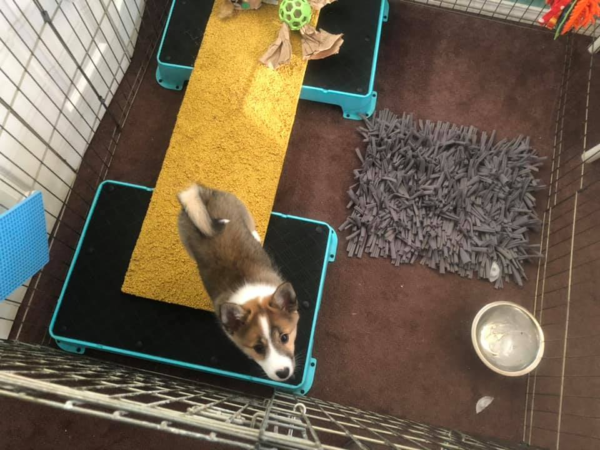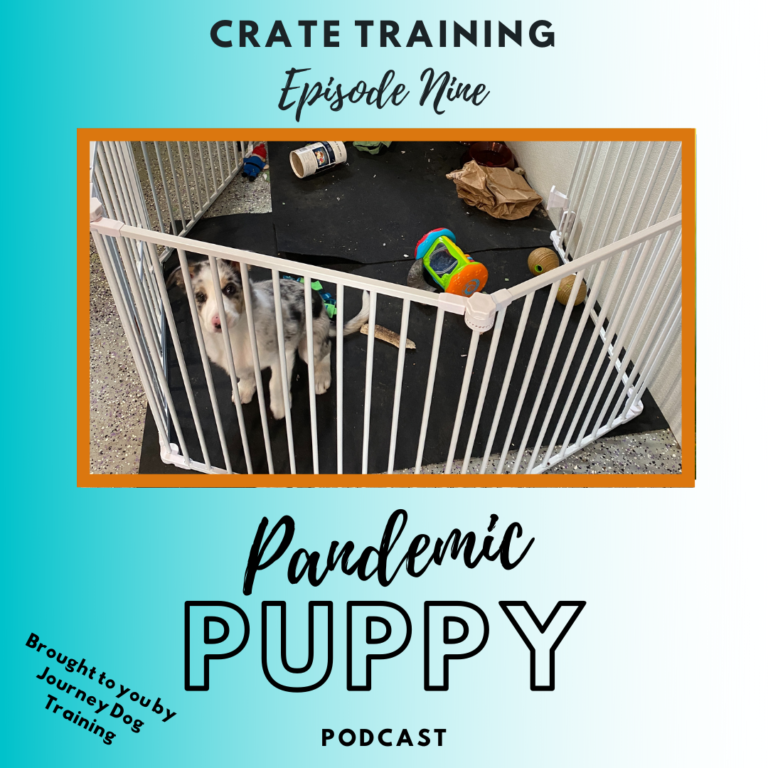For episode nine, Kayla Fratt speaks with Sarah Stremming from The Cognitive Canine all about crate training with your puppy.
For more Journey Dog Training Resources on Crating, check out:
- Crate Training A to Z E-book
- My Puppy Hates Her Crate but is Well-Behaved Otherwise, What Do I Do?
- Why Does My Puppy Keep Peeing in His Crate?
Do puppies need to be crate trained?
- Just like everything else we do in training, it depends on what your goals for your puppy are. There is not a universal answer. That said, we both crate train our dogs!
Are there alternatives?
- If you do not wish to use a crate, baby gates or x-pens are a great option to create a room or space for the puppy. If you do want to use crates, it is still recommended to have a separate space using baby gates or xpens along with the crate.
How do you start crate training?
- The pen should be highly enriching for the puppy. It should have a sleeping spot, an enriching area, and a potty area.
- It is best to start crating during sleep times only at first.
- You don’t want to put them in the crate if they aren’t sleepy/going to fall asleep. The puppy should learn that the crate is for sleep time. If you notice your puppy is sleepy, put them in the crate. If you can, put the crate inside the xpen, making that the place for sleeping.




What problems can you prevent with crating?
- Prevents chewing items you don’t want chewed
- Makes housetraining is much easier
- Prevents conflict between puppy and other animals in the home
- Prevents boredom biting when the puppy is trying to get your attention
- You would have to be constantly micromanaging them if they didn’t have their own space to be in, which could really affect your relationship with your puppy
How do your goals play into crate training plans?
- In order to have success with this, you can’t ask them to do something they can’t do. You don’t teach by letting them get it wrong.
- Work your way up to where you want to be with a plan, you can’t rush your dog if they aren’t ready to give you the goal you desire
- You don’t get it by doing it, you get it by doing other things that approximate it
- ie. if you want your dog to be good with flying in a crate, they have to be good with driving in a car first
- Teach the prerequisite skills first
- If your puppy can’t wait quietly in their pen while you go to the bathroom, then your puppy won’t be able to be quiet in their crate when you run to the store.
How can listeners make their crates ultra-enticing to their puppies?
- Change it up frequently
- Licky mat, put up obstacles for them to get to it
- Tug toy hanging
- Snuffle matt and snuffle ball
- Numerous toys of different kinds
- Bones and bully sticks
- Boxes and packing paper for them to rip up or shred
- Puppies should be doing “over, under and through”
How can the 4 steps to behavioral wellness help you with crate training?
- The four steps of behavior wellness are exercise, enrichment, nutrition, and communication
- Exercise and enrichment are the most important to focus on that will help with crate training, as crating isn’t completely natural for them as it is confinement.
- When they tell you they are tired, let them be done.
- They need to have enough enrichment so that they are satisfied.
- Think about it like this: “If you lived in one room and that was your whole world, what would you need to feel satisfied and enriched?”
How can you help your puppy learn to like going into the crate?
- Only train entering and exiting the crate so they know that the crate is not a working space
- Mark and reinforce when they go in on their own
- Duration can be taught through boredom. Start with crating them while being busy doing something else that they aren’t really interested in. Just as if they were in the crate while you were driving a car. Don’t allow them to panic.
What are your thoughts on pacifiers like Kongs? How can they be used well for crate training?
- Use them carefully. Pacifiers can backfire if/when overused because they can teach your dog to be fine only if eating
Many people don’t struggle as much with getting their puppy to go into the crate as they do getting their puppy to settle in the crate for longer periods of time. How do you teach puppies to stay in the crate for longer periods of time?
- Make sure they are not constantly distracted in their crate when you leave the room. They need to learn to be okay with you being gone. Being distracted does not mean they are okay.
- Don’t let them be completely distressed, if they want out, maybe try putting your fingers through the crate or bring the crate closer to you, but don’t let them out if you are sure all their needs are met.
Are there any advantages or disadvantages to crate training during the pandemic?
- You have an opportunity to have the best chance of avoiding separation anxiety with proper crating and foundations.
How can people avoid creating a dog who’s trying to earn rewards in the crate (ie offering behaviors)?
- Make sure you put them in the crate when they are tired often
This podcast is supported by Journey Dog Training and our Puppy Raising Blueprint course. If you’re feeling lost with puppy raising, check out this course at journeydogtraining.com/blueprint. The full course covers topics ranging from common problem behaviors and socialization to the humane hierarchy of dog training. It’s all taught by yours truly, Kayla Fratt. If you need more personalized training support, check out journeydogtraining.com – we have a variety of courses, e-books, and remote training services available.
This podcast is also supported by our members on Patreon. For as little as $3 per month, you can support this podcast and get perks like submitting questions for us to tackle at the end of each episode. Sign up over at patreon.com/pandemicpuppy.
Over the next few episodes, we’ll cover puppy-raising lessons from a service dog trainer, self-regulation skills for puppies, and developmental stages for puppies.


As a single owner of a high-drive, busy border puppy, crate training is a big priority for me. But, it had been so easy with my adult rescue girls that I was not prepared for how tricky it would be to with my new pup. But making a couple of changes after listening to this podcast has made such a difference for both of us! And better sleep for him makes him a way nicer critter to live with!
Oh I’m SO glad to hear that! Yay!